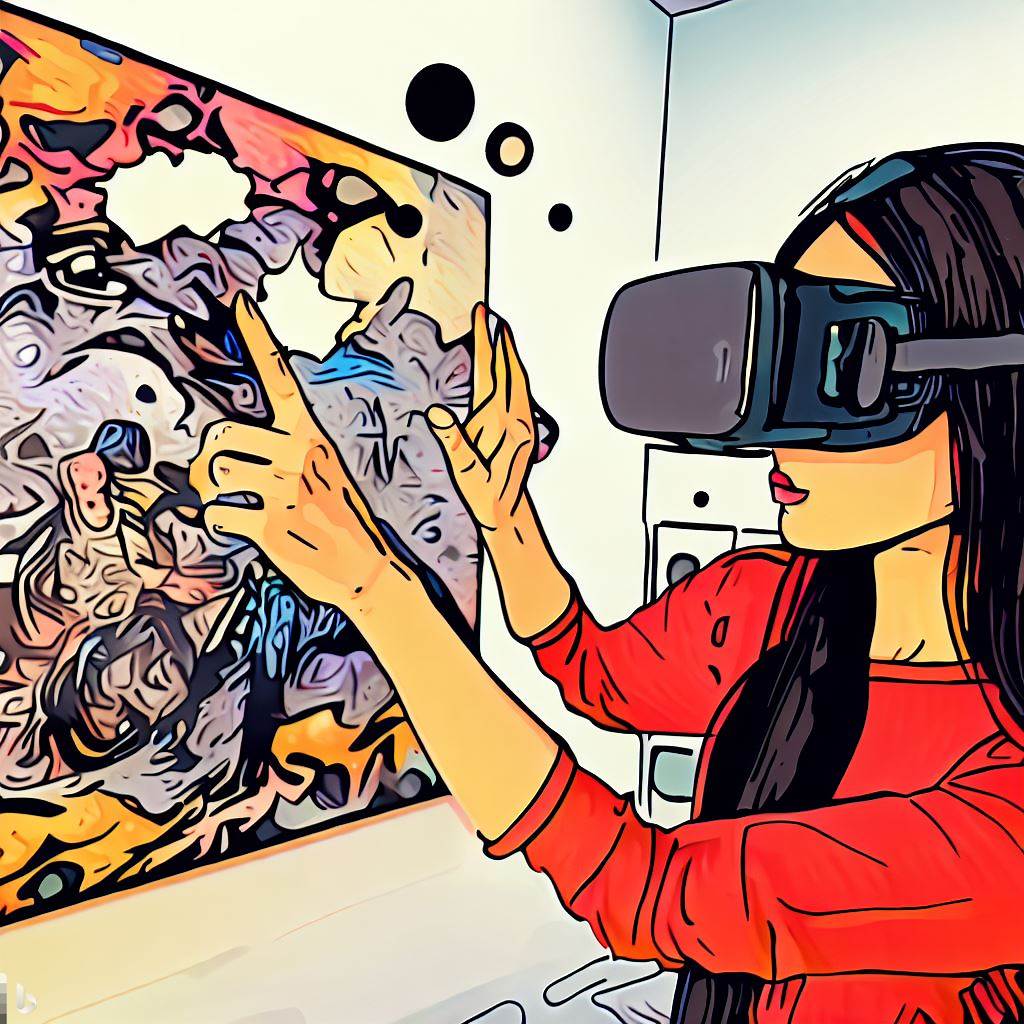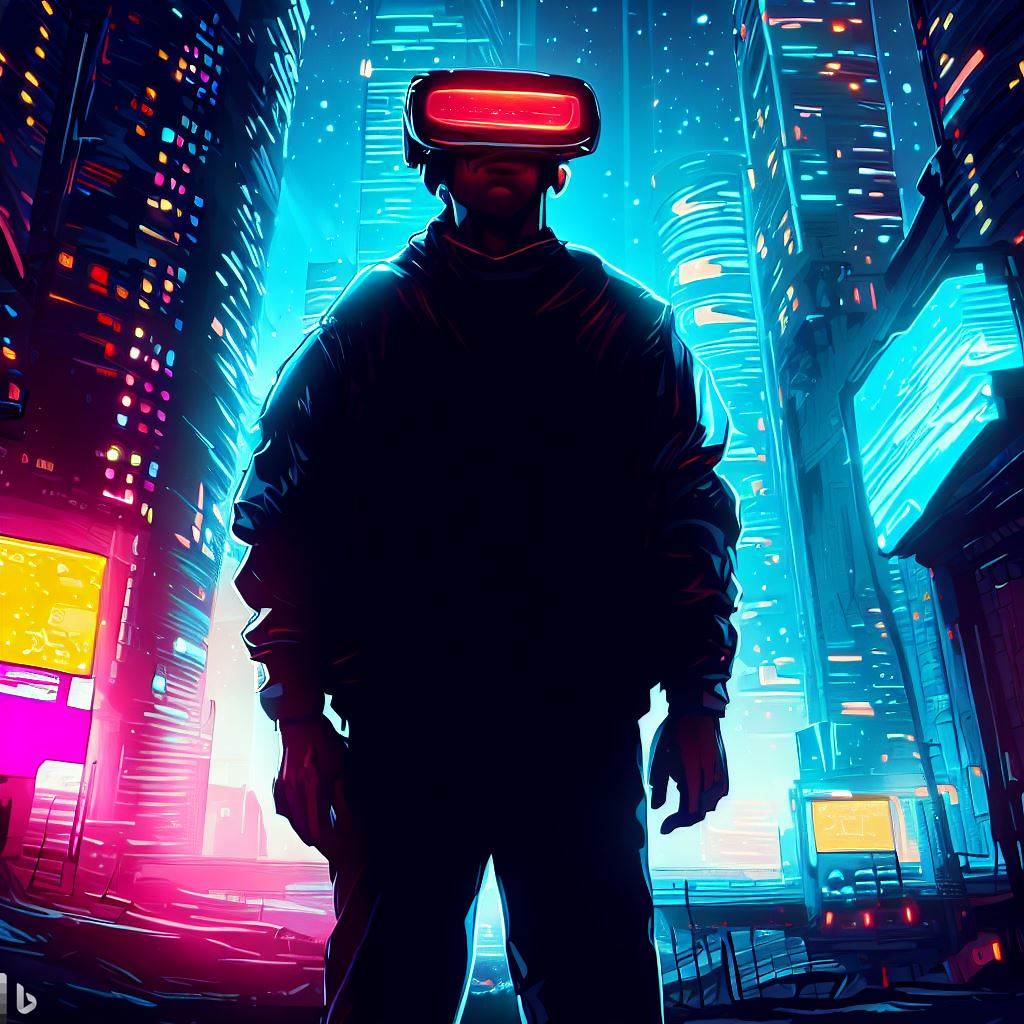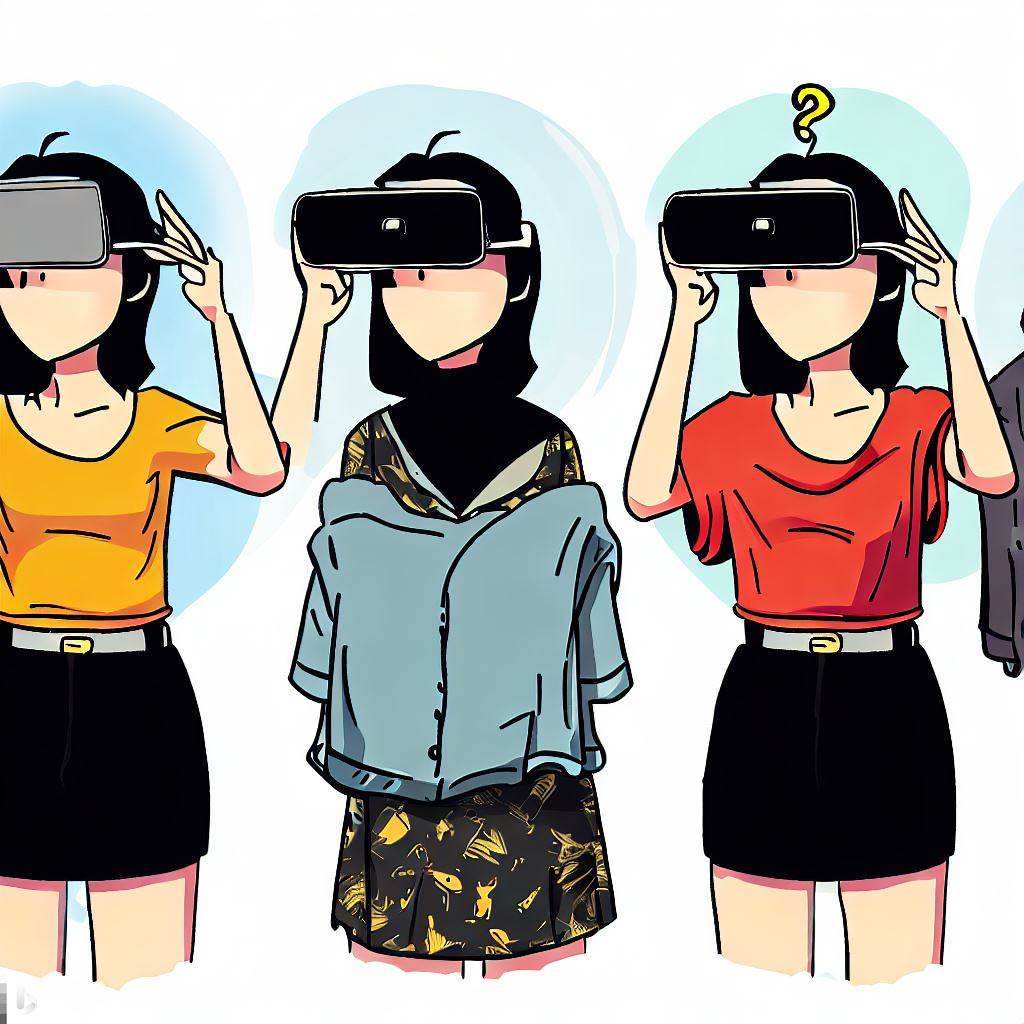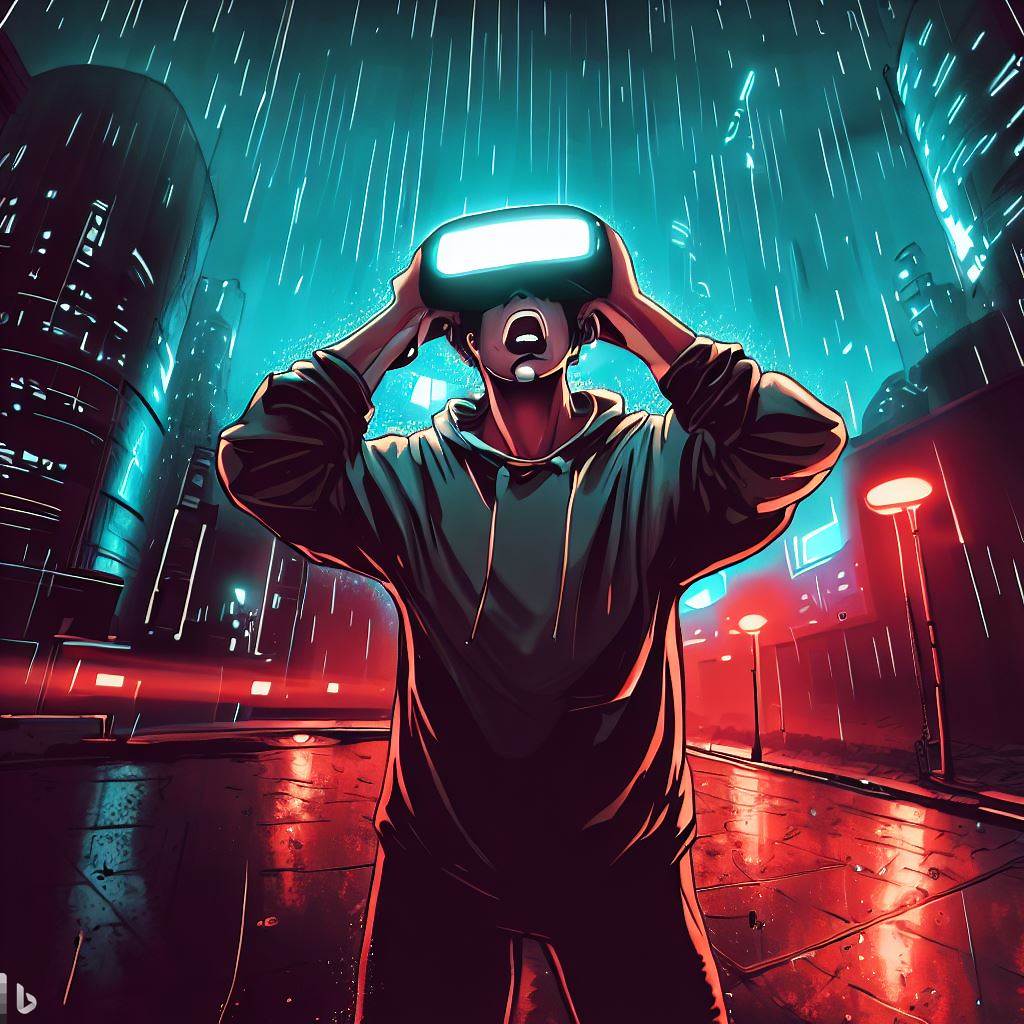The challenges of the metaverse involve fostering global collaboration, promoting ethical behavior and inclusivity, and carefully balancing the virtual economy with real-world consequences.
Imagine walking through a bustling digital city, brushing shoulders with avatars from all over the world.
One moment, you’re attending a virtual concert with your favorite artist, and the next, you’re exploring a digital art gallery with friends.
Welcome to the metaverse, the immersive, interconnected digital universe.
But, as with any new frontier, the challenges of the metaverse can be both thrilling and daunting.
Buckle up, partner, because we’re about to embark on a wild ride through the lesser-known, mind-bending aspects of this digital realm. 🚀
Challenges of Metaverse: Digital Property Rights & Ownership Dilemmas

Picture this: you’ve just splurged on a jaw-dropping virtual mansion in the metaverse, complete with a private beach and a state-of-the-art home theater. 😎
But then, a sneaky thought crosses your mind: “What exactly do I own in this digital realm?”
Well, buckle up, because we’re about to dive into the murky waters of digital property rights and ownership dilemmas in the metaverse.
Virtual Real Estate: Whose Land is it Anyway? 🏠
Just like in the real world, the metaverse has its share of virtual real estate. But who’s calling the shots when it comes to ownership? Digital property rights can be a tangled web, with questions surrounding intellectual property, licensing, and transferability of assets.
So, what’s the deal? Well, the lines are still pretty blurry, but some platforms have implemented their own property rights systems. For instance, Decentraland uses non-fungible tokens (NFTs) to establish digital property ownership. It’s a step in the right direction, but we’ve still got a long way to go.
The Intellectual Property Conundrum: Who’s Got the Rights? 🧠
Let’s talk about intellectual property (IP) in the metaverse. It’s a real head-scratcher. 🤔 With user-generated content flooding the digital realm, it’s tough to keep track of who created what, and who has the rights to use it.
To make matters more complicated, different platforms have their own terms of service that govern IP ownership. This can lead to all sorts of gray areas and potential disputes. Remember that amazing virtual artwork you created? Better read the fine print, because you might not have full control over it after all.
To License or Not to License? That is the Question 📜
Licensing is another tricky aspect of the metaverse. Do you need permission to use someone else’s digital assets? What about creating a virtual replica of a famous landmark or celebrity? 😲
The truth is, the rules are still being written, and it’s a bit like the Wild West out there. Some platforms have taken steps to introduce licensing systems for their digital assets, but many questions remain unanswered.
Transferability: Can I Take My Cool Stuff with Me? 🎒
Imagine having a super rare virtual item that you want to show off in different metaverse platforms. Well, that’s where transferability comes into play.
Unfortunately, not all platforms allow for the seamless transfer of assets between them. It’s like trying to fit a square peg in a round hole. 🤷♂️ The interoperability of digital assets across platforms is an ongoing challenge, and it’s something that needs to be addressed for the metaverse to truly thrive.
The Future of Metaverse Ownership: Charting Uncharted Territory 🌐
We’re still in the early days of the metaverse, and the challenges of metaverse ownership are aplenty. But as the digital universe evolves, so too will the rules that govern it.
For now, it’s important to stay informed and aware of the potential pitfalls when navigating the metaverse’s property rights landscape. One thing’s for sure: the road ahead is bound to be full of surprises and plot twists.
So keep your eyes peeled and your virtual wits about you as we continue our journey through the fascinating world of digital property rights and ownership dilemmas in the metaverse. 🌌
As more players enter the metaverse, the need for standardization and collaboration among platforms becomes crucial. Whether it’s through the development of cross-platform protocols or industry-wide agreements, the future of metaverse ownership depends on a harmonized approach.
A Call to Action: Embracing Change and Innovation 📣
While the challenges of metaverse ownership may seem daunting, they also present a unique opportunity for innovation and progress. By embracing change and working together, the metaverse community can shape a digital landscape that is fair, inclusive, and full of exciting possibilities.
So, what can you do? Stay engaged, participate in discussions, and don’t be afraid to share your ideas and concerns. After all, the metaverse is not just a digital playground for tech giants – it’s a collective space where every voice matters.
To sum it up, the challenges of metaverse ownership are far from being resolved, but with a collaborative spirit and a commitment to innovation, we can pave the way for a brighter, more interconnected digital future.
And who knows? Maybe one day, we’ll all be proud digital homeowners in the metaverse, waving at our neighbors from our pixel-perfect virtual porches. 🏡👋
Facing the Technological Hurdles: Connectivity & Infrastructure Issues

The metaverse is a sprawling, ever-expanding digital landscape, offering limitless possibilities for exploration, creation, and connection.
But, just like a daring tightrope walker, it can’t reach its full potential without a solid foundation beneath it. 🎪
In this section, we’ll tackle the technological hurdles that the metaverse must overcome, focusing on connectivity and infrastructure issues.
The Need for Speed: Internet Connectivity in the Metaverse 🌐💨
As the old saying goes, “speed is of the essence.” This rings true for the metaverse, where seamless, high-speed internet connectivity is essential. But, alas, not everyone has access to a speedy connection, and this can hinder their metaverse experience.
Here’s a quick breakdown of how internet speed impacts the metaverse:
- High-speed connections: Smooth, immersive experiences with little to no lag 🚀
- Moderate-speed connections: Occasional lag and slower loading times, but still manageable 🏃♂️
- Low-speed connections: Frustratingly slow, with frequent buffering and a less-than-ideal experience 🐢
So, how can we address this issue? It’s all about bridging the digital divide and ensuring that high-speed internet is accessible to all. This may involve investing in infrastructure, fostering competition among ISPs, and promoting affordable internet plans.
The Building Blocks: Infrastructure Challenges 🏗️
The metaverse relies on robust, scalable infrastructure to support its ever-growing user base and the mind-boggling array of virtual experiences it offers. Here are some of the key infrastructure challenges that need to be addressed:
- Server capacity and scalability: As more people flock to the metaverse, there’s an increasing strain on server capacity. Scalability is crucial to ensure the digital realm doesn’t buckle under pressure.
- Interoperability: Seamless integration between various platforms and technologies is key for a truly interconnected metaverse.
- Security and stability: Protecting user data and ensuring the stability of the metaverse ecosystem are non-negotiable priorities.
Collaboration is Key: The Path to Overcoming Technological Hurdles 🔑
The challenges of metaverse connectivity and infrastructure can’t be solved by any single entity. It requires a collaborative effort from governments, tech companies, and the metaverse community.
Here are some ways we can work together to overcome these hurdles:
- Government initiatives: Investing in infrastructure, promoting digital literacy, and ensuring affordable internet access for all
- Tech companies: Developing innovative solutions to improve connectivity, scalability, and security within the metaverse
- Metaverse community: Engaging in discussions, providing feedback, and supporting initiatives that promote an inclusive, accessible digital realm
Together, we can pave the way for a metaverse that truly transcends geographical and technological boundaries, allowing everyone to partake in the digital revolution. So, let’s join forces and tackle these technological hurdles head-on, and make the metaverse a reality for all. 💪
The Social Impact: Addressing Inclusivity and Accessibility in the Metaverse

As we venture deeper into the metaverse, it’s crucial to remember that this digital realm is more than just a playground for cutting-edge technology. It’s a place where people from all walks of life can connect, create, and collaborate. 🤝
But for the metaverse to truly live up to its potential, we must address the critical issues of inclusivity and accessibility.
In this section, we’ll explore the social impact of the metaverse and discuss ways to ensure that everyone can enjoy this brave new world.
Inclusivity: Leaving No Avatar Behind 👫
Inclusivity is the backbone of a thriving metaverse. It’s about creating an environment where everyone feels welcome, valued, and supported. Here are some key areas to consider when it comes to fostering inclusivity:
- Cultural representation: The metaverse should be a melting pot of cultures and identities, where everyone can express themselves authentically. This includes diverse virtual spaces, avatars, and user-generated content that reflect the rich tapestry of our global community.
- Language diversity: As a global phenomenon, the metaverse must cater to speakers of various languages. Implementing translation tools and multilingual support can help bridge linguistic barriers and foster better communication.
- Safe spaces: The metaverse should be a place where everyone can feel safe and protected. This means implementing effective moderation tools, community guidelines, and reporting systems to combat harassment, discrimination, and other harmful behaviors.
Accessibility: Opening the Virtual Door for All 🚪
Accessibility is all about breaking down barriers and making the metaverse a welcoming place for people with disabilities or special needs. Here’s how we can make the metaverse more accessible:
- Assistive technologies: Integrating tools like screen readers, voice recognition, and closed captioning can make the metaverse more navigable and enjoyable for users with visual, auditory, or mobility impairments.
- Universal design: By embracing the principles of universal design, we can create virtual spaces that are easily accessible and usable by everyone, regardless of their abilities. This includes designing with clear navigation, intuitive interfaces, and customizable settings.
- Community support: Fostering a supportive community that is aware of accessibility needs and willing to help others can make the metaverse a more inclusive space. Encouraging users to share their experiences and providing resources for learning about accessibility can go a long way.
Shaping the Future of the Metaverse: Our Collective Responsibility 🌏
The journey towards a more inclusive and accessible metaverse is a collective effort. It requires the active participation of governments, tech companies, and everyday users. Here’s how we can all play a part:
- Governments: Implement policies and regulations that promote inclusivity and accessibility in the digital realm, as well as invest in initiatives that support digital literacy and infrastructure.
- Tech companies: Develop and implement features that prioritize inclusivity and accessibility, while actively engaging with users to gather feedback and address their concerns.
- Users: Embrace diversity and be open to learning about different cultures, languages, and accessibility needs. Support one another in the metaverse and advocate for positive change.
Together, we can shape a metaverse that is truly representative of our diverse global community, where everyone can explore, create, and connect without barriers. By addressing the social impact of the metaverse, we can unlock its full potential and build a digital realm that is inclusive, accessible, and empowering for all.
Navigating the Ethical Minefield: Dealing with Misinformation and Manipulation

In our quest to understand the challenges of the metaverse, we must confront a dark and thorny issue: the ethical minefield of misinformation and manipulation.
Just as these problems plague our physical world, they can infiltrate the digital realm, sowing discord and undermining trust. 🌪️
In this section, we’ll delve into the complexities of misinformation and manipulation in the metaverse, and discuss strategies for navigating this ethical quagmire.
The Misinformation Menace: Untruths in the Metaverse 🦹♂️
Misinformation, or the spread of false or misleading information, can manifest in various ways within the metaverse, from deceptive marketing tactics to the dissemination of fabricated news. As the metaverse grows, so too does the potential for misinformation to wreak havoc on our digital lives.
Here are some key aspects to consider when addressing misinformation in the metaverse:
- Fact-checking: Encouraging the use of fact-checking tools and promoting media literacy can help users distinguish between reliable and dubious sources of information. 🕵️♀️
- Content moderation: Implementing robust content moderation systems can help identify and remove misinformation before it has the chance to spread. 🚨
- Community engagement: Fostering a community that values truth and accuracy can create a supportive environment where users feel empowered to challenge misinformation and seek out reliable sources. 🤝
The Manipulation Minefield: Guarding Against Digital Deception 🕷️
Manipulation in the metaverse can take on many forms, from social engineering and phishing attacks to deepfake technology and artificial intelligence-driven impersonations. Navigating this treacherous terrain requires vigilance, education, and a commitment to ethical behavior.
Here are some ways to guard against manipulation in the metaverse:
- User education: Raising awareness about manipulation tactics and providing resources to help users recognize and avoid them is essential. Knowledge truly is power in the fight against digital deception. 💡
- Security measures: Implementing strong security measures, such as multi-factor authentication and encrypted communications, can help protect users from falling victim to manipulation. 🔐
- Ethical AI: Developing and adhering to ethical guidelines for AI usage can prevent the misuse of advanced technology for manipulative purposes. 🤖
Charting a Course through the Ethical Minefield: Our Collective Responsibility 🗺️
The battle against misinformation and manipulation in the metaverse is a collective effort, requiring collaboration between governments, tech companies, and users. Here’s how we can all play a part:
- Governments: Establish policies and regulations that hold those who spread misinformation and engage in manipulation accountable. Support initiatives that promote digital literacy and ethical behavior online.
- Tech companies: Develop and implement tools that detect and mitigate misinformation and manipulation. Foster a culture of transparency and ethical responsibility within the metaverse ecosystem.
- Users: Stay informed about the dangers of misinformation and manipulation, and actively engage in efforts to combat them. Be a voice for truth and integrity within the metaverse community.
By working together, we can navigate the ethical minefield of misinformation and manipulation in the metaverse, fostering a digital realm that is built on trust, honesty, and ethical behavior. Let’s chart a course through these challenges and emerge stronger, wiser, and more united than ever. ⚓️💪
The Metaverse Economy: Balancing Virtual Currency and Real-World Consequences

Welcome to the brave new world of the metaverse economy, where virtual currency and real-world consequences collide in a dazzling display of innovation and complexity. 💸🌐
In this section, we’ll dive deep into the economic landscape of the metaverse, examining the delicate balance between virtual currency and its real-world implications.
Virtual Currency: A Whole New World of Transactions 🪙
The metaverse economy is fueled by virtual currencies, which enable users to buy, sell, and trade goods and services within the digital realm. These currencies come in many shapes and sizes, from platform-specific tokens to decentralized cryptocurrencies. Let’s take a closer look at the key characteristics of virtual currencies:
- Digital: Virtual currencies are entirely digital, which means they’re easily transferable and can be used for transactions without the need for physical cash or credit cards.
- Decentralized: Many virtual currencies, such as cryptocurrencies, are decentralized and not subject to the control of a central authority, like a government or financial institution.
- Volatile: The value of virtual currencies can be highly volatile, with prices subject to rapid fluctuations in response to market trends and speculation.
Key Players in the Virtual Currency Ecosystem
To better understand the virtual currency landscape, let’s get acquainted with some of the key players:
- Platforms: Virtual worlds and platforms often have their own native currencies, which can be used to purchase in-game assets or services.
- Cryptocurrencies: Decentralized digital currencies like Bitcoin and Ethereum play a crucial role in the metaverse economy, enabling cross-platform transactions and serving as a store of value.
- Stablecoins: Pegged to a stable asset like the US dollar, stablecoins provide a less volatile alternative to traditional cryptocurrencies.
Real-World Consequences: When the Virtual and Physical Worlds Intersect 🌍
The metaverse economy doesn’t exist in a vacuum; it has real-world consequences that can’t be ignored. Here are some of the most pressing issues to consider:
- Taxation: Virtual currency transactions can have tax implications, with many jurisdictions treating digital assets as taxable property. It’s crucial to understand the tax laws governing virtual currency transactions in your jurisdiction.
- Regulation: As the metaverse economy grows, so does the need for regulation. Governments and financial institutions are grappling with the challenge of creating a regulatory framework that promotes innovation while protecting users and maintaining financial stability.
- Financial risks: Virtual currency investments can be risky, with the potential for significant losses due to market volatility, hacking, and fraud. Users should be aware of these risks and exercise caution when engaging in virtual currency transactions.
Striking the Balance: Navigating the Metaverse Economy ⚖️
So, how can we find the sweet spot between the excitement of virtual currency and the real-world consequences that come with it? Here are some strategies for achieving balance in the metaverse economy:
- Stay informed: Educate yourself about the virtual currencies you’re using, including their value, volatility, and potential risks.
- Be cautious: Exercise caution when investing in virtual currencies or engaging in high-risk transactions.
- Know your tax obligations: Understand the tax implications of your virtual currency transactions and stay up-to-date with the latest tax laws and regulations in your jurisdiction.
- Advocate for sensible regulation: Support the development of fair, balanced, and forward-thinking regulations that promote innovation while protecting users and the broader economy.
As we continue to explore the fascinating world of the metaverse economy, it’s crucial to recognize the delicate balance between virtual currency and real-world consequences. By staying informed, exercising caution, and advocating
Conclusion
The metaverse presents an array of challenges, including digital property rights, technology, social impact, ethical concerns, and the virtual economy. Addressing these issues requires a united effort from governments, tech companies, and users worldwide.
To unleash the metaverse’s potential, we must prioritize collaboration, inclusivity, accessibility, and ethical behavior. Balancing virtual currency and real-world consequences is also crucial to building a thriving digital environment.
As we navigate the metaverse, let’s embrace these challenges as opportunities for growth and innovation. By tackling them head-on, we can create a digital world that reflects our imagination, resilience, and commitment to a brighter future. 🚀🌟




